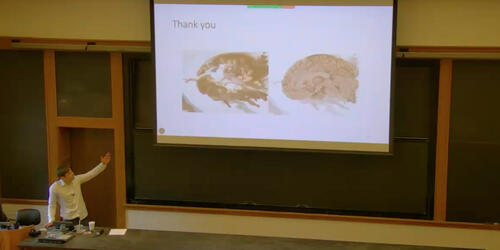
On May 15, Heraclitos Lefcochilos-Fogelquist successfully defended the thesis “Characterizing and modelling spectral state dynamics in human cortex” (Advisor: John Murray).
Lefcochilos-Fogelquist explained, “Our research investigates how emergent, large-scale brain dynamics evolve over time during rest. We developed a novel methodological framework to robustly characterize spectral shifts within these dynamics and found that the brain’s natural oscillations can transition between distinct dynamical regimes – shifting from diffusive, desynchronized activity to rhythmic, synchronized patterns across cortical areas. These shifts might correspond to changes in brain state, such as varying levels of alertness. Using computational modeling, we then examined the underlying dynamical processes driving these shifts, providing new insight into their potential mechanistic origins. Looking ahead, our methodological approach and results may enhance our understanding of how large-scale brain dynamics change in both healthy and disease settings.”
He will be rejoining RTW Investmentss as an Investment Intern.
Thesis Abstract
There is increasing evidence that the large-scale spectral dynamics of human cortex can exhibit non-Gaussian features and marked variation over a range of timescales in resting state. Robust documentation and characterization of such complex phenomena, however, remains a challenge and is comparatively sparse, given the paradigmatic complexity of the human brain. Here, we adopt a methodological approach which can account for dynamic changes in spectral signals of electrophysiological data by explicitly using a measure of spectral variation over time, for which we can generate single-variable time courses, enabling robust characterization of the real-time activity of spectral modes across various timescales. With it, we identify a spectral mode, encompassing the 2-40 Hz range, which can undergo global shifts in bimodal dynamical regimes – driven by a single signal, mapping to all cortical areas, that moves between unimodal Gaussian, arrhythmic long-tailed, and rhythmic bimodal Gaussian dynamics. We propose that these distinct dynamical regimes correspond to putative state changes, and hypothesize that their appearance is an index of low arousal. We then parsimoniously recapitulate the observed dynamics and their shifts using a canonical model of nonlinear dynamics under stochastic fluctuation and adaptation, and propose an alternative mechanism for cortical bimodality. Collectively, this work marks a meaningful contribution to our understanding of the complexity inherent in human cortical spectral dynamics.